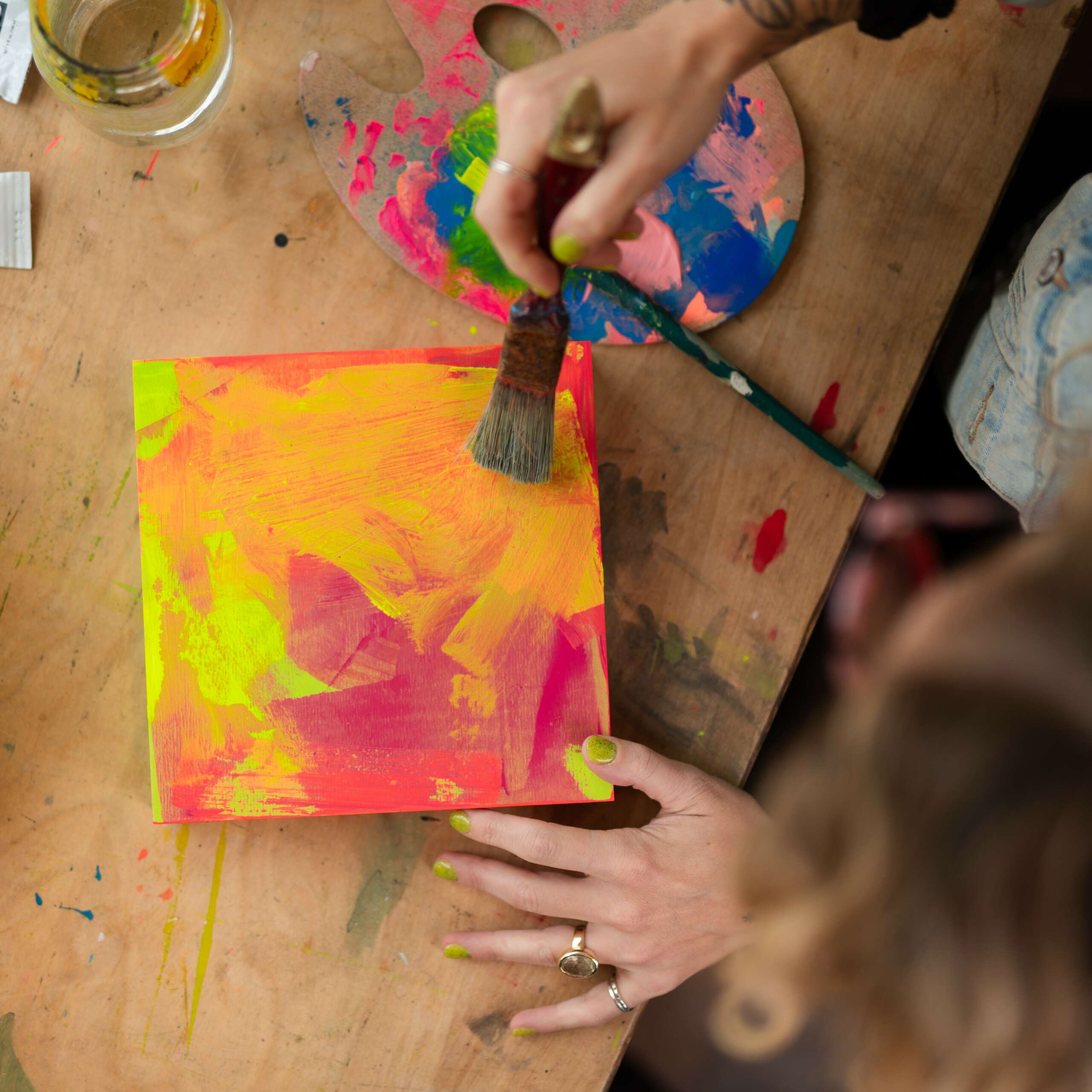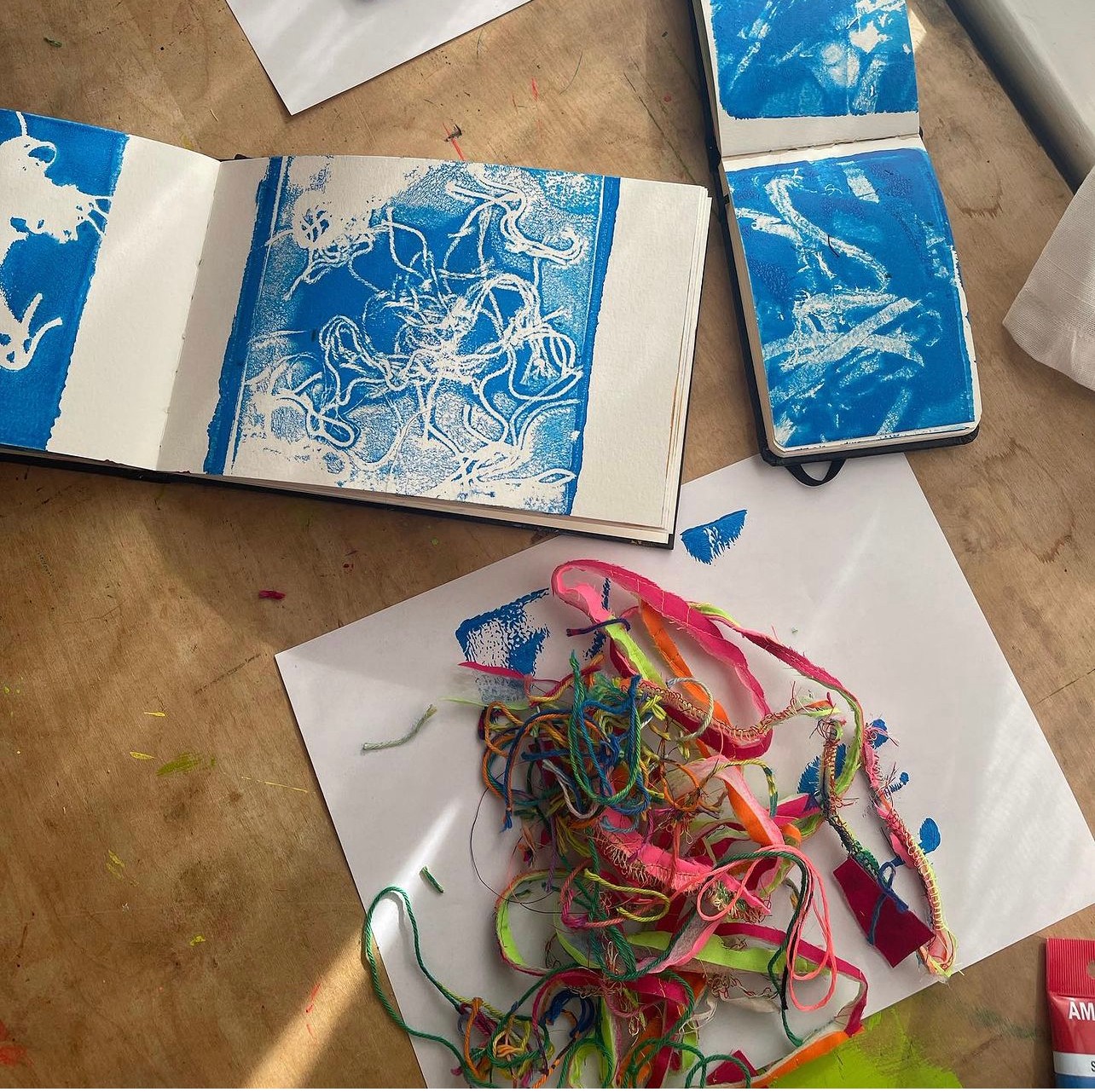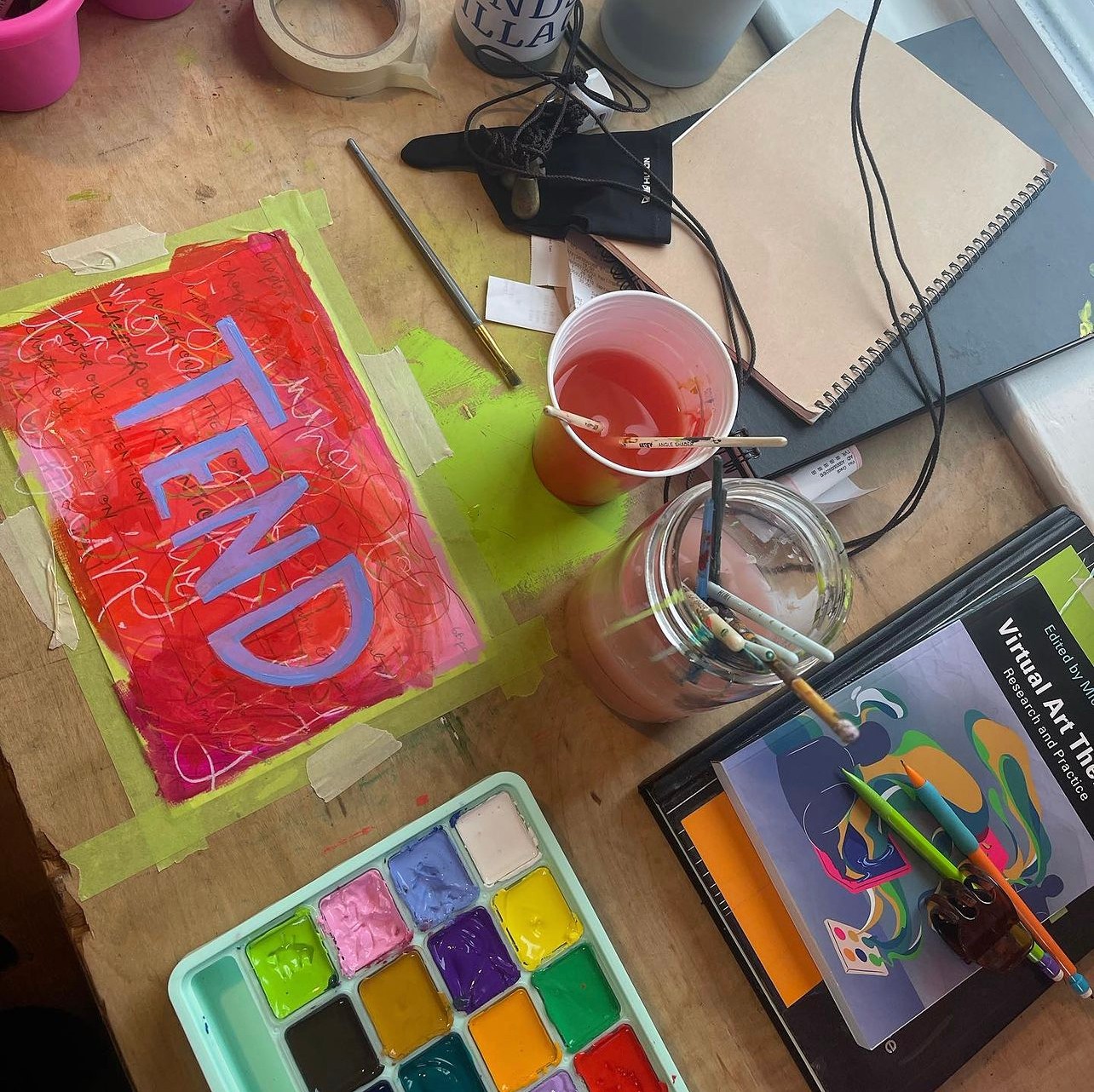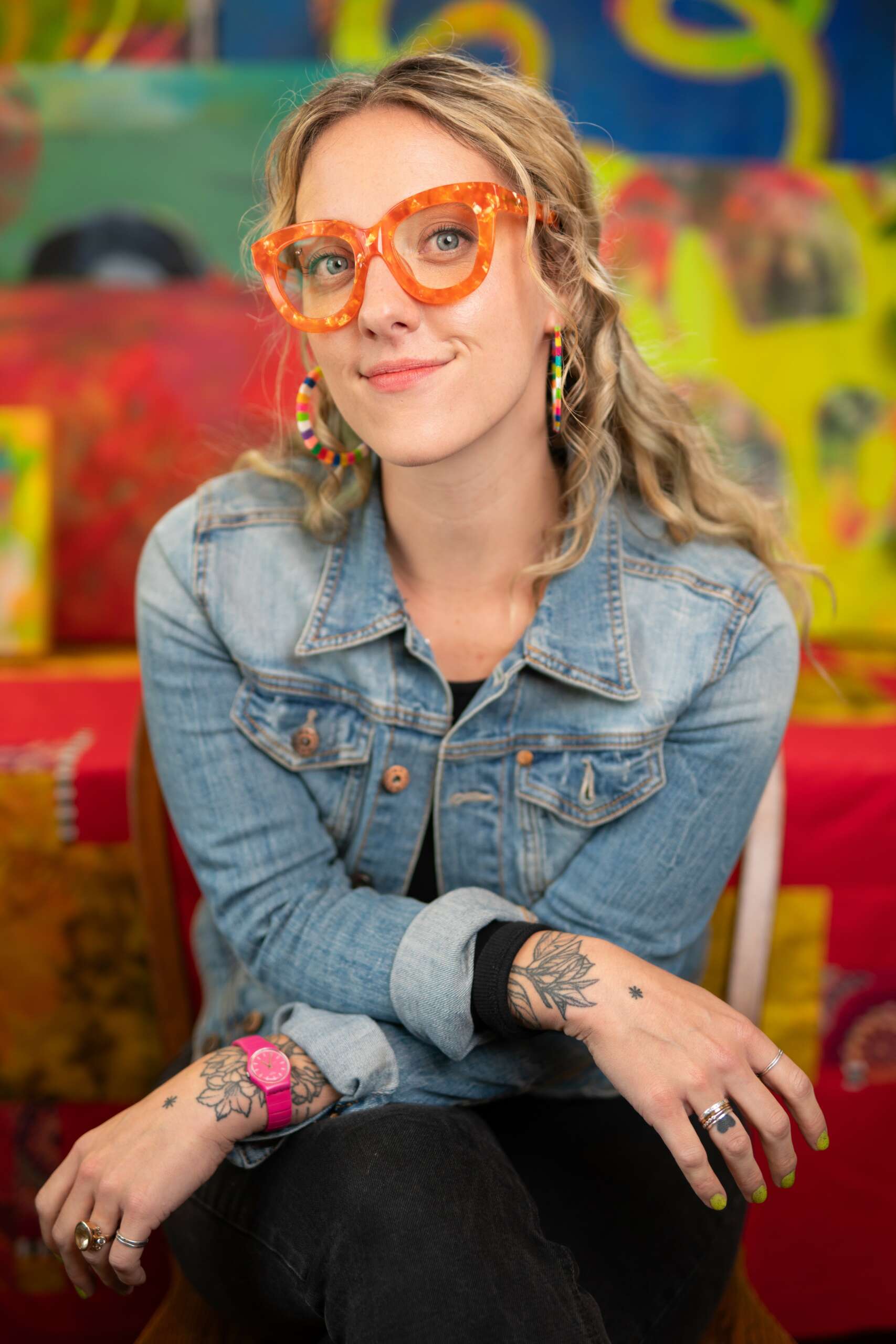Alright – so today we’ve got the honor of introducing you to Amelia Knott. We think you’ll enjoy our conversation, we’ve shared it below.
Alright, Amelia thanks for taking the time to share your stories and insights with us today. Was there a moment in your career that meaningfully altered your trajectory? If so, we’d love to hear the backstory.
The defining moment of my work happened before my career even started.
I was two months shy of completing my degree in art therapy when the pandemic hit. My training had been hands-on; for two years I’d studied the meeting place between psychotherapy and creative expression. The magic of art therapy comes from the tactile experience we have when we make things. It’s a profound act to take a feeling from inside ourselves and use our hands to give it shape, texture, weight, and colour outside our bodies. Art materials give us an opportunity to practice agency over something else— we get to author a new story in a tangible, creative way. We get to see and feel the evidence of our problem-solving and our resilience.
During my training, I expected to one day have a spacious studio, overflowing with art materials. I imagined inviting my future clients to move through the space, touching paint, clay, beads, and paper. I imagined helping them to hang their art on the walls before standing back to marvel at what they’d made. My hope for the future was shaped by the things I expected to see, touch, and share with the people I would work with.
It was devastating to watch the world change so abruptly. My graduate school transitioned to online learning and we tried to replicate the power of the art studio in Zoom rooms. My peers and I graduated into an unprecedented future where being in person and sharing supplies might not be possible. I wondered if the modality I’d devoted myself to would be possible in our ‘new normal.’ Before a vaccine we had no idea if or when we would ever gather in person again. The most fearful part of me worried that my training would be useless in the context of social distancing.
My despair asked me to pivot.
I scrapped the thesis I’d been researching and turned my attention toward the new question I needed answers for: How can art therapists adapt to the digital age? Instead of academic research, I tried to create something practical for all my colleagues grappling with the same uncertainty. The question took on the form of a podcast as I interviewed therapists pioneering telehealth techniques. The podcast’s title, *Art Therapy IRL* (“in real life”), was a tongue in cheek way of describing the tension between life online and offline. During that period of research in lock down, digital spaces began to feel vital to my wellbeing. My “real life” now seemed to include my digital footprint. As the internet became a more crucial tool in my work and relationships, It didn’t feel correct to exclude time online from my definition of reality.
The ethos of that podcast laid the foundation for my business. I founded an entirely online private practice, offering clinical art psychotherapy to clients and facilitating groups and “open studio” sessions on Zoom. Over time, it felt possible to create strategies for translating the goodness of art therapy for the digital world.
The internet played a pivotal role in my first years of business, both as an ally and an adversary. I like to call myself an ‘accidental content creator’ because my social media presence started as a creative outlet and a place to share about art therapy. I didn’t expect TikTok and Instagram to take up as much (if not more) energy as my clinical work. My growing presence on social media is what has allowed my work to thrive AND the realities of participating in the attention economy took a tole on my mental health. For me, social media is like an open faucet of information, criticism, connection, and inspiration. Working online and showing up on social media meant that the boundaries between my professional and personal life blurred together. My phone became a source of both validation and shame.
My tangly relationship with social media led to the second defining question of my career: What does wellness mean when we choose to be online? I needed an answer for myself, and also heard clients and other social media users grappling with the same discomfort. So many of us don’t have the financial or social leverage to extricate ourselves from the digital tools that facilitate our work and relationships. I started to see a hole in the self-help literature and a need for a more nuanced conversation about why we go online and how we can care for our mental health when we do.
Art, luckily, is the best tool I can think of for holding a paradox. I began reading, creating, and researching about how creative practices might support mental health in the digital age. That inquiry has culnimated in my forthcoming book, The Art of Thriving Online; Create Exercises to Help You Stay Grounded and Feel Joy in the World of Social Media. It’s a workbook of therapeutic art and writing prompts for anyone looking to reflect on their relationship with social media.
If you’d asked me five years ago to predict what my career would look like, I would have described myself in an art studio, holding space for grief and trauma. At first, turning towards the possibilities of online work seemed like the solution to a practical problem. I didn’t expect digital wellbeing to become the cornerstone of my work. The defining moment of my career has been allowing that unexpected question to hold my curiosity. It’s been following the tension of online life and using art to hold open the possibility of something new.


Great, appreciate you sharing that with us. Before we ask you to share more of your insights, can you take a moment to introduce yourself and how you got to where you are today to our readers.
I am a Registered Psychotherapist, art therapist, author, and private practice owner.
I entered the field of art therapy because creativity is how I have always processed emotions and made sense of the world. During my undergraduate degree at The Maryland Institute College of Art, I focused on community arts; using creativity as a tool for grassroots organizing, social justice, and community building. I found myself craving deeper clinical skills to support healing through art and decided to move back to Canada to pursue an art therapy degree.
Art therapy is different from traditional talk therapy because it includes visual expressions of emotion. It’s possible to explore situations and feelings that are challenging to put into words and it gives clients to ability to connect with the visual parts of their brains. It’s an incredibility effective modality for addressing trauma and other mental health concerns.
In my practice I see individual clients for art psychotherapy. Accessibility is also important to me, so I offer groups and workshops that are open to the public. Over time, my focus has shifted to creating resources that help folks use art to navigate the barriers posed by hustle culture and the attention economy. I think creativity is something we can all use to care for ourselves in a society that demands perfection and immediacy. I try to discuss the systemic barriers to wellbeing in my social media content and facilitation.



What’s a lesson you had to unlearn and what’s the backstory?
A lesson I’ve had to unlearn is that marketing must be all consuming.
I think business owners, especially those of us socialized into feminine roles, often hear the message that we have to offer the public unrescrited access to our lives to be successful. It’s true that online audiences want to connect to the person and the story behind a brand. The result is that our entire lives can become content for public consumption. What does work/life balance mean when we’re constantly performing lifestyle for a digital audience?
In the early days of my business, most of my time was spent creating content and growing a following. It was addictive. Showing up on social media is what allowed me to start a private practice and support myself and my family. Over time, the unpaid labour of social media left me feeling burned out. When I started writing my book I realized I didn’t have the creative energy to show up on social media consistently and embark on the most demanding creative project of my life.
When I stepped away to write I was afraid that the foundation of my business would crumble. That fear wasn’t unfounded – the algorithm penalized me for no longer being a regular poster. But my digital hiatus helped me break a cycle of seeking validation online. It helped me to remember that I’m allowed to keep large portions of my life just for myself and that I don’t owe anyone intimacy, access, or responsiveness. Those are lessons I carry with me as I return to social media to share about the book I’ve written.
How’d you build such a strong reputation within your market?
Digital ethics is something I think about a lot.
As a mental health professional, I have to follow a different set of rules from many business owners online. Marketing in the wellness industry is full of client testimonials, promises about the outcome of services, affiliate marketing, and other strategies that are not always trauma-informed. The way I navigate social media is guided by the ethical codes of the regulatory bodies I belong to and my duty to my clients. When I talk about my work I need to protect their identities and consider how what I share might impact our therapeutic relationship. I’m also thinking about the wider cultural implications of how I discuss topics related to mental health. My intention is to be congruent—to show up on social media in the same way I show up in clients sessions. I never want to make assumptions, prescribe one-size-fits-all solutions, or create false urgency in my messaging.
I think my training as a therapist has made me a thoughtful contributor to the wellness discourse on social media.
Contact Info:
- Website: https://www.arttherapyinreallife.com/
- Instagram: https://www.instagram.com/art_therapy_irl/
- Other: TikTok: https://www.tiktok.com/@art_therapy_irl My podcast: https://open.spotify.com/show/2swKStAO0p2zVmQwi26pU5?si=97b306f3b7c34c40 My book: https://www.amazon.ca/Art-Thriving-Online-Workbook-Exercises/dp/1649632738/ref=sr_1_1?crid=9OCF05YHFZ0K&dib=eyJ2IjoiMSJ9.rMjMzXNv5XfkLfXNm8iKteqfrJ-_XXFA4ucmwJea7qKCPanekshJDm5Mlc8RK9KAjkq-L9k9-JCjyGWEOSvnsaY0cpAIIq2uKOlhCXj_A79hfs_0SO4ydrSbGwjUQHezjw7pZpqOfdZJbGciqrW6l6ZatCWexLQTZ-L-DniGQwpkN5qDPw_MndPli_MG8lXUptVcQs7NJ2HuV2bAYafG1cEyN1RbN7CdoJRHRYZS3H99yCh4JyG46EGeIxuRuNyCoLbeCcAfca2V7TgwdWEa8jA0lsW3-f5V1MCk65NMCEg.JwZuinjcRhCXu3WOJfanVqfNQIFf1Q5J_uC7I7_YqoQ&dib_tag=se&keywords=the+art+of+thriving+online&qid=1713217757&sprefix=the+art+of+thriving+online%2Caps%2C195&sr=8-1
Image Credits
Kenton Doupe 2023


